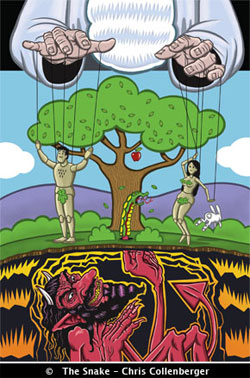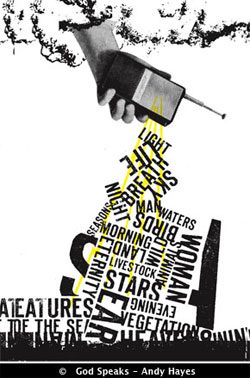Packaging is everything. And by packaging I don’t mean a jar with a label on it. But the way certain things are packaged for a smoother ride down people’s throats — sometimes harshly and unexpectedly, sometimes willingly and enjoyable, sometimes superficially and unmemorable and other times deceptively and unwarranted. Whether it is the news as packaged by FOX News or Michael Moore, video games by PTAs or Wired magazine, postpartum depression by Tom Cruise or Brooke Shields, everything is subject to a delivery method best suited for the receiver as decided by the sender. And, without passing any judgment, religion (of all kinds and in all forms) has always relied on packaging.
 How can religion reach more people? What can it do to entice more participation? Why aren’t more people devoted to it? As varied and open-ended as these questions are, there are as varied and open-ended cultural, political and societal entities (no pun intended), with equally varied and open-ended intentions, methods and goals looking for the next big thing in religious activation (1). And no target audience needs more activation (or is more desired to be activated) today than the coveted 18 to 34 year-old demographic. TV networks, movie studios and every retail shop this side of The Gap fight over this crowd. So why shouldn’t religion? More specifically, why shouldn’t the Bible? Ever since Gutenberg first laid down some major quantities of blackletter to reproduce the Bible, the book has been printed as many times as there are stars in the sky [exaggeration added by the author] and has been continually given the star treatment with fabulous book binding techniques. Yet, the Bible is still the Bible. Old and New. No two ways to go about it. Well, no four ways about it maybe. 2003 saw the publication of Revolve: The Complete New Testament, aimed at teenagers and upping the volume on the mainstream knob, pop quizzes and all, in a teen magazine format. Revolve is now in its third edition and has had the benefit of controversy and “best-selling” marketing status. Rendering it a success. The latest addition to the alternate visualization of the Old and New Testaments is Relevant Book’s Postmodern Bible Stories.
How can religion reach more people? What can it do to entice more participation? Why aren’t more people devoted to it? As varied and open-ended as these questions are, there are as varied and open-ended cultural, political and societal entities (no pun intended), with equally varied and open-ended intentions, methods and goals looking for the next big thing in religious activation (1). And no target audience needs more activation (or is more desired to be activated) today than the coveted 18 to 34 year-old demographic. TV networks, movie studios and every retail shop this side of The Gap fight over this crowd. So why shouldn’t religion? More specifically, why shouldn’t the Bible? Ever since Gutenberg first laid down some major quantities of blackletter to reproduce the Bible, the book has been printed as many times as there are stars in the sky [exaggeration added by the author] and has been continually given the star treatment with fabulous book binding techniques. Yet, the Bible is still the Bible. Old and New. No two ways to go about it. Well, no four ways about it maybe. 2003 saw the publication of Revolve: The Complete New Testament, aimed at teenagers and upping the volume on the mainstream knob, pop quizzes and all, in a teen magazine format. Revolve is now in its third edition and has had the benefit of controversy and “best-selling” marketing status. Rendering it a success. The latest addition to the alternate visualization of the Old and New Testaments is Relevant Book’s Postmodern Bible Stories.
Published and designed by the decidedly contemporary Relevant Media Group, a network revolving around “forward-thinking, spiritually hungry twentysomethings”, Postmodern Bible Stories is a collection of 45, postcardable key stories from the Old and New Testaments as rendered by 30 illustrators accompanied by their statements on their work and preceded by punchy introductions. The premise, ”Sunday school never looked like this,” seems to hold true throughout the book, with unconventional (by Bible standards) illustrations. The marketing spin of the book, on the other hand, seems to falter at very turn of the sentence. The book is dubbed as “risk-taking”. I failed to see any risks taken. Mel Gibson — that’s risk-taking. It then labels it as “a spiritual conversation”. I studied the Old Testament ad nauseam (and in Hebrew, thank you very much) when I was younger (I failed miserably when tested) so I found the relaxed, “street” language amusing and an interesting writing exercise, but nothing more. Certainly not a conversation of spiritual standards. Lastly, the biggest selling point of the book, its illustrators.
Postmodern Bible Stories bills them as “some of the best illustrators and designers in the world”. Some of the illustrators are actually quite good — specifically Mark Sgarbossa, who exploited this book to show a brilliant range of styles, and Rex Crowle’s deceptively humorous Jonah and the Whale illustration, which he described simply as “It’s a fish, with a guy hiding inside it” — and I was visually surprised by some of the illustration but I would not be so trigger-happy with any “Best of” attributions to this group. Some entries were technically poor, others were conceptually off target while others just relied on software illusions and three- or five-year-old trends. Overall, it all seemed to try too hard to live up to the “Postmodern” title. Another subject of contention I presume. But given the ambiguity, and lack of agreement, of the term itself I feel like at this point anyone thinking they are doing something different should just feel free to slap the “Postmodern” tagline on anything. It must be postmodern to someone, somewhere. But I digress. Following is a sampling of some of the illustrations I enjoyed for different reasons:

As I mentioned earlier, this is one of my favorites. Besides the playful simplicity, it is the sailor’s hat that really does it for me.

I am a fan of thick-stroked illustrations and bright colors, so this one satisfies. However, I don’t remember anything about the snake being the devil, but as I said, I never quite paid a lot of attention.

God using a walkie-talkie and condensed sans serif just seems funny.

Not great, but of all the illustrations that used typography, this was by far the best.

Another one of my favorites. The colors and compisition are visually (even one of the few emotionally) strong.
Postmodern Bible Stories is packaged with conviction from its publisher — and is done so in perfect harmony with the the rest of their books and overall enterprise — and at first glance is a valiant effort in making the Bible cool. I imagine I am somewhat removed from their target audience, so I would be very interested to see how others perceive this attempt but, for me, this was a package better left wrapped.
1) Activation is a term used to specify an audience or space that needs to be, well, activated. From an empty corner of a sports arena that can be activated with a mini Hooters to a kid in a playground getting free samples of the latest in sports shoe technology. Given my somewhat sarcastic description you can tell that this is a term I do not embrace.
![]()
Postmodern Bible Stories: Sunday School Never Looked Like This
Paperback: 45 pages
Publisher: Relevant Books (April, 2006)
ISBN: 0976817519






I hate this shit -- especially the bloodless illustrations and their simplistic, direct correspondence to the subject matter.
If it was truly "postmodern," there would be doubt; and heaven forbid there's any doubt in the evangelistic rank and file. Derrida's "Of Grammatology" critiqued the direct relationship between signifier and signified as "logocentrism" -- a "theological" construct — and described a slipperiness between the two.
If anyone is interested in a more postmodern religious tale, I suggest Jean-Luc Godard's Je vous salue, Marie, aka Hail Mary, where Mary plays basketball and works in a gas station, Joseph drives a taxi, and a stranger named Gabriel informs her that she's pregnant. Granted, there's a scene where Mary masturbates in an attempt to connect with God, but it's one of Uncle Jean's more spiritual works.
Otherwise, there's always Sister Corita.
"Postmodern Bible Stories" is, on the other hand: simpering claptrap.
Feh.
Now watch, all the Christian Scientologists will make comments about how I'm either attacking Christianity or some sort of self-hating ex Catholic -- to which I say "hogwash." My argument is with the book, its editors, the illustrations and the book's marketing.
On Jun.20.2006 at 02:31 PM